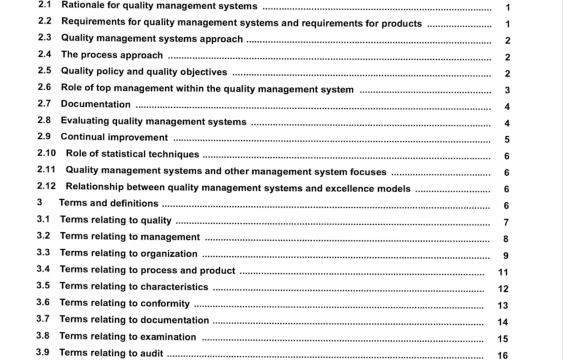ISO 9000 pdf download – Quality management systems —Fundamentals and vocabulary.
The use 01 s*alisticat techniquas can help ii understanding varabdety, and thereby can help organizations to solve problems and improve effectiveness and eflciency. These techniques also facilitate better use of available data to assist e decision maklng
Variability can be oeserved in the behaviour and outcome of many activities, even under conditions of apparent stability Such variability can be observed m meas&able characteristics of products and processes and may be sean to exist at various stages over the lila cycle of products from market research to customr service and final disposal,
Statistical techniques can help to measure describe, analyse. interpret and model such variabuldy, even with a relatively Iriled amount of data. Statistical analysis of such data can help to provide a better understanding of the nature, extent and causes of variabullly. thua helping to solve and even prevent problems that may result from such variablIit and to promote continual improvement
Guidance on statistical techniques in a quality management system is given in ISOITR 10017.
2.11 Quality management systems and other management system focuses
The quality management system is that pan of the or anizat.on’s management system that focuses on the achievement of results, in relation to the quality objectives, to satafy the needs, expectations and requwemenes of interested parties, as appropriate. The quality ob,ectives complement other obectives of the organization such as those related to growth, funding, profitability, the environment and occupational health and safely. The various parts of an organization’s management system might be integrated, together with the quality management system, into a sIngle management system using common elements. This can faobtate planning, allocation of resources, definition of complementary objectives and evaluation of the overall effectiveness of the organization. The organization’s management system can be assessed against the organization’s management system requsments. The management system can also be audited against the requirements of International Standards such as ISO 9001 and ISO 14001. These management system audits can be carned out separately or in combination.
2.12 RelationshIp between quality manag.ment systems and excellence mod.Ls
The approaches of quality management systems given in the ISO 9000 (amity of standards and in organizational excellence models are based on common princles. Both approaches
a) enable an organization to identify its strengths and weaknesses,
b) contain provision for evaluation against generic models
C) provide a basis for continual ImprOvement, and
CS) contain provision for external recognition.
The differenca between the approaches of the quality managemerd systems in the ISO 9000 famdy and the excellence models lies in thaw scope of application. Th ISO 9000 famity of standards provides requrements for quality management systems and guidance for performance improvenient evaluation of quality management systems determines tuililment of those requirements. The excellence models contain coterie that enable comparative evaluation of organizational performance and this is applicable to ci activities and all interested parties of an orgarnzation. Assessment chleria In excellence models provide a basis for an organization to compare its performance with the performance of other organizations.
3 Terms and definitions
A term in a definition or note which is defined elsewhere In thits clause is iodicated by boldface followed by its entry number in parentheses. Such a boldface term may be replaced in the definition by Its complete definition. For example:
NOTE I The bern qjaMty’ can be Led eei ad)eetPma ajdi poor good or excelant
NOTE 2 •beiecenq, oppceed to assagned, means existlig in something. nepoclay ex a p rwianeri* die erstic.
31.2
requirement
need or expectation that Is staled, generally inlied or obligatory
NOTE I Genery ln,pued meerie that tile custom crconvnon practice tar the orgamzalbei (3.3.1). its cuatom.,. (33.5) and other lnt.r..kd partIes (3.3.7), that the need or espectallon isider consideration is Wrøed.
NOTE 2 A qiiati%r can be used to denote a ripodftc t’pe of reqtarement e.g. odod eqrkement, qusity rnsnagement reqwem, Customer rea’emenL
NOTE 3 A speciled reqrirnnicnt one that is stated, tIr exane Ii a document (31.2). NOTE 4 Req.eements can be generated by diffr,rnnt Interested partIes (3.3.7).
NOTES This defpiition iSifers from that provsted m 3.12.1 of ISOf1EC DWectkee. P1 2t2004.
3.12.1
requirement
expression lithe contard of a cinasnent conveying aitarla to be tiied If rxmipliaicc w*h the docasnent b to be dalned and from etudi rio deeston Is pererilted
3.1.3
grade
Category or rank given to &fferen# quality requirements tar products (3.4.2), processes (3.4 1) Cr systems
(3,2.1) having the same functional use
EXAMPLE Class of aluine tic*( and category at hotat In a hotel wide.
NOTE When estatlafirig a quality requWem. the grade Is genery specIfIed.
3.1.4
customer satisfaction
cuslomes perception at Ihe de-ee to wfach the cusloma-’s requirements (3.1.2) have been fulNied
NOTE 1 Customer xinilaInts we a corranon Ixticatar of customer satisfaction but thaW aence does not necesaw*y Irrçly high customer sedsllon.
ISO 9000 pdf download – Quality management systems —Fundamentals and vocabulary
